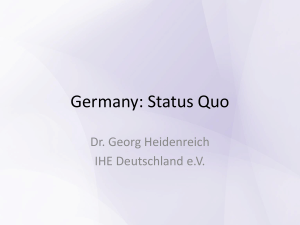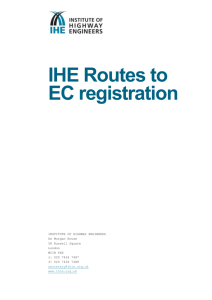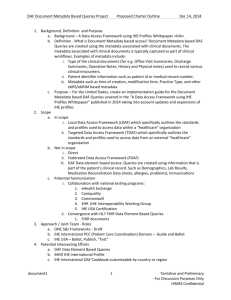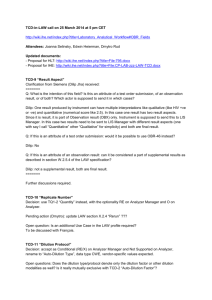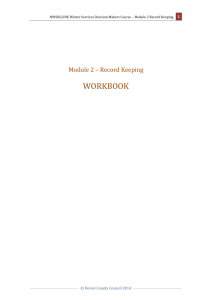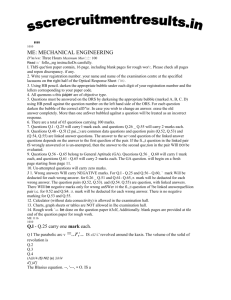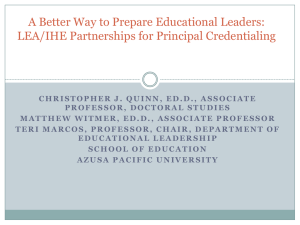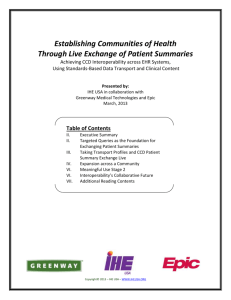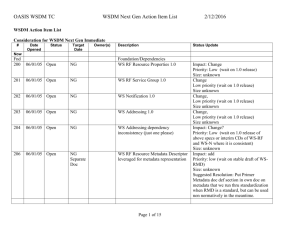IHE Professional Certificate - The Institute of Highway Engineers
advertisement
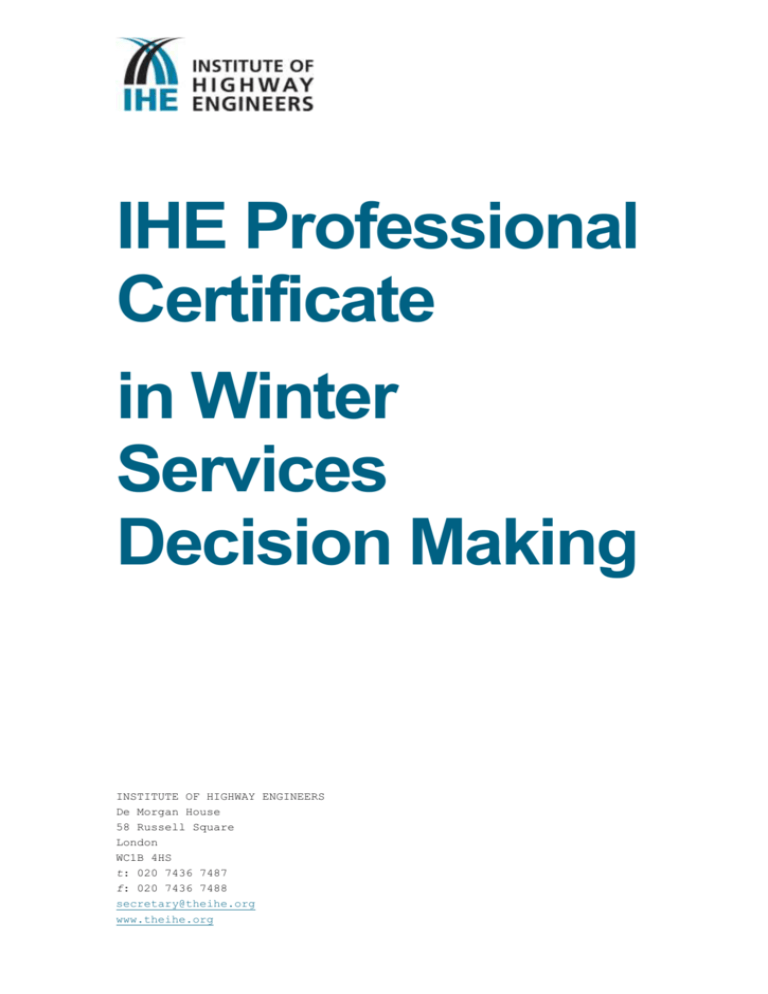
IHE Professional Certificate in Winter Services Decision Making INSTITUTE OF HIGHWAY ENGINEERS De Morgan House 58 Russell Square London WC1B 4HS t: 020 7436 7487 f: 020 7436 7488 secretary@theihe.org www.theihe.org This document explains How you benefit from an IHE Professional Certificate How to apply The purpose of the Certificate interview How you benefit The IHE Professional Certificate in Winter Services Decision Making provides Tangible evidence to your employer and future employers of your proven competence in WSDM Independence assessment of your knowledge and performance in WSDM which stands up in court Access to IEng registration marking you out as a professional For authorities and consultants the benefits include Tailored comprehensive learning in Winter Services Decision Making Tested competence against industry-set standards Competitive advantages as an employer of proven competent staff The Certificate is open to all. You do not need to be, or to become, a member of IHE nor do you have particular academic qualifications. You are required to prove that you meet the standards of competence, and must have attended and passed the assessment of the IHE Winter Services Decision Makers Course. Candidates who have attended the IHE Winter Services Decision Makers Course and successfully completed the course assessment can submit an Assignment and discuss it at an interview with two Assessors. There is no application fee. With the IHE Professional Certificate you will be offered membership of IHE if you have either a NC or higher academic qualification or sufficient years of experience. You may also be able to register as an Engineering Technician. Ask IHE to advise you. WSDM February 2014 020 7436 7487 | www.theihe.org Page 2 of 6 Need Help? If you are unsure, please contact our Membership Manager on 020 74367487 or email membership@theihe.org. How to apply Step One Read the attached WSDM assignment requirements, which reflect the competency standards for each module of the course. You are seeking to show the assessors that you know and apply the principles listed to a work environment. Step Two Open a folder and place the following into it: Completed IHE Application form (WSDM 10) Copies of your academic certificates (post-school) Your CV (make sure it explains your various jobs) Your job description and organisation chart with your post highlighted Step Three Write a description of recent work, which shows you cover the WSDM competence statements, as detailed on the attached sheets. Aim for 300-400 words per module on average with a typical total of 2500-3000 words. Be guided by the marks available for each section. Describe clearly the research that you have done where you do not have direct personal experience and your personal input and responsibilities. Describe where applicable your experience to date and evidence that you have researched within your own organisation. Say more about the recent evidence where you have exercised greater responsibility. Explain what you did and why by reference to national and local recommendations, policy and good practice. Include any graphics or diagrams which assist your explanation. We want to know what you did and why – use “I” not “we”. Step Four At the same time put together a few key documents to back up your written explanation. Put these as Appendices to your Report. Make two copies of your course assignments. Please clearly annotate your assignment with the relevant headings that have been identified. Please avoid repetition, by cross-referencing to other sections if there is some relevant information that covers more than one section. Step Five Put all the papers from Step Two with your Assignment into a folder with a Contents List. WSDM February 2014 020 7436 7487 | www.theihe.org Page 3 of 6 Ask your line Manager to review and sign off your folder. Keep the originals and send one copy to IHE by the closing date. Style Guide for Written Work In preparing your assignments, portfolio or any report, it is good practice to: word process the text using one and a half line spacing on one side of A4 leave a line between paragraphs use headings and subheadings number the sections, paragraphs and pages number any photos, tables in the text number any attachments and prepare a list of the attachments get the assignments bound or use a ring binder reduce plans if possible or fold them into a plastic wallet include photos, sketches or plans to help to explain the site justify your reasoning, comments and recommendations by reference to national and local standards or best practice advice make clear the extent of your responsibilities Make sure your submission is easy to handle and to find your way around. Use good English Be precise Check your grammar and spelling: ask colleagues to look over the text Write short sentences Use plain English words Ask a colleague to proof read the report for technical accuracy. What happens at IHE IHE will acknowledge receipt of your application, pass on the information you supplied and give you contact details for your assessors. Send your assignments and submission to the two assessors by the Post Office. IHE will tell everyone the time and date of the interview and give you details of the venue. Afterwards, the assessors make a recommendation to the IHE Winter Services Steering Group and IHE’s Membership & Qualifications Committee. The purpose of the interview The assessors want to reassure themselves that your knowledge covers that listed in the Competence Standards. They will ask your questions about your assignments and about how you have applied your WSDM knowledge in practice with reference to your experience. The assessors will set you at your ease. The interview is not an examination: it is a discussion with senior colleagues. No one interview is WSDM February 2014 020 7436 7487 | www.theihe.org Page 4 of 6 the same as another. The assessors have their own styles but their conduct must be fair and proper. Their assessment will be based entirely on the work submitted and your performance on the day. Beforehand, Identify significant or interesting aspects of your work to talk about Practice talking about your work Think about questions you could be asked and your answers Refresh your knowledge of the competency requirements On the day, Your assignments or Portfolio will have been read by the assessors. They will ask you questions to test your knowledge and competence to satisfy themselves that you meet the Statements of Competence. You will be given a number of weather scenarios on the day, given some time for preparation and then asked to talk through your decision making process based on the scenarios. Remember to listen to the questions say what you mean, logically and clearly take comments objectively, not as a personal slight stop digging if you get into a hole: don’t waffle. Afterwards IHE will write to you after the next Committee with your results and provide further information if you wish to be considered for election as a member of the Institute. The IHE Professional Certificate accredits your competence, marks you out as a qualified professional, and is backed by senior DC professionals – your employers. ADVANCE YOUR CAREER WSDM February 2014 020 7436 7487 | www.theihe.org Page 5 of 6 WSDM February 2014 020 7436 7487 | www.theihe.org Page 6 of 6

